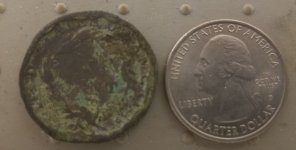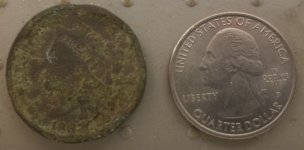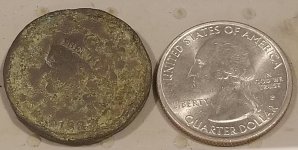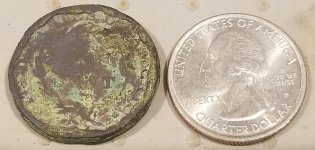invent4hir
Bronze Member
- Aug 1, 2017
- 1,798
- 2,747
- 🏆 Honorable Mentions:
- 3
- Detector(s) used
- Whites V3i & DFX
- Primary Interest:
- All Treasure Hunting
All, found this coin near a home built by a Quaker family in 1833 and later owned by a blacksmith for 60 years. The home has been inhabited ever since and the property farmed.
First thing I noticed when I pulled it out of the dirt was how thick the rim was (3mm) — compare to a modern quarter in the first photo. Next the interior of the rim on the reverse side has edges (second photo) like a Susan B. Anthony dollar coin. Then I saw the Liberty head facing left (third photo).
When I got home I looked at 1837 coins in my book and saw none with a reverse side with edges like the coin I found. After some cleaning I could make out part of the branches on the reverse side, as well as, part of ONE CENT and STATES OF AMERICA. The diameter of 26 mm is slightly smaller than the 27.5 mm of a 1837 Large Cent.
Before posting I searched TNet and compared it to other counterfeit LGs found and a 1837 Hard Times Token. No match.
So is this a real, counterfeit or play 1837 Large Cent?
First thing I noticed when I pulled it out of the dirt was how thick the rim was (3mm) — compare to a modern quarter in the first photo. Next the interior of the rim on the reverse side has edges (second photo) like a Susan B. Anthony dollar coin. Then I saw the Liberty head facing left (third photo).
When I got home I looked at 1837 coins in my book and saw none with a reverse side with edges like the coin I found. After some cleaning I could make out part of the branches on the reverse side, as well as, part of ONE CENT and STATES OF AMERICA. The diameter of 26 mm is slightly smaller than the 27.5 mm of a 1837 Large Cent.
Before posting I searched TNet and compared it to other counterfeit LGs found and a 1837 Hard Times Token. No match.
So is this a real, counterfeit or play 1837 Large Cent?








 Happy Easter!
Happy Easter!
